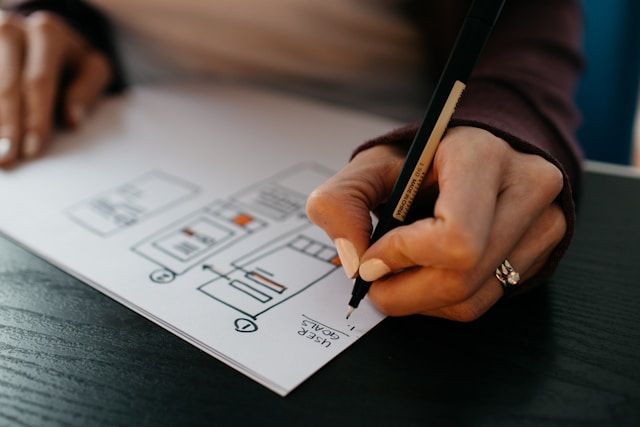Web design is more than just making a site look good; it’s about creating an intuitive, engaging, and efficient experience for users, these practical tips for the best web design can work a must-have and handy guide to save and have at your disposal whenever it’s needed.
A well-designed website can significantly impact your audience’s perception of your brand, their user experience, and ultimately, your business’s success, thus, it is pivotal to focus on tailored-made development for your website, this will help address your specific needs with your goals and users’ intent in mind.
It’s important to keep a balance between aesthetics and functionality, as you’ve experienced, it’s common to come across websites that are beautiful, yet not functional, easy to navigate or are slow to download. On the other hand, many times a business can be of the highest quality for their web design is simply visually unpleasant, which can create hesitation on the user and lose trust.
Here are some essential tips for crafting the best web design:
1. Prioritize User Experience (UX)
Understand Your Audience
Before you start designing, it’s crucial to understand who your audience is and what they expect from your website. Conduct user research to gather insights into their preferences, behaviors, and needs. This information will guide your design decisions and ensure your site meets user expectations.
Simplify Navigation
Navigation should be intuitive and straightforward. Use a clear and consistent menu structure, and make sure users can easily find what they’re looking for within three clicks. Include a search bar to enhance accessibility.
Mobile Optimization
With the increasing use of mobile devices, ensure your website is fully responsive. A mobile-friendly design adjusts seamlessly to different screen sizes and provides a consistent user experience across devices.
2. Focus on Visual Hierarchy
Use Whitespace Effectively
Whitespace, or negative space, helps create a clean and uncluttered design. It allows users to focus on important elements and improves readability. Don’t be afraid of empty space—use it to your advantage.
Prioritize Content
Arrange content in a way that guides users through the site. Use larger fonts and bolder colors for headings and important information. Visual cues like arrows or contrasting colors can direct attention to key areas.
Consistent Branding
Maintain consistency in your use of colors, fonts, and imagery to strengthen your brand identity. Consistent branding builds trust and recognition among your audience.
3. Enhance Loading Speed
Optimize Images
Large images can slow down your site. Compress images without losing quality and use appropriate formats. Tools like TinyPNG or JPEG-Optimizer can help with this.
Minimize HTTP Requests
Reduce the number of elements on your page that require HTTP requests, such as scripts, images, and CSS files. Combining files can also help speed up loading times.
Use a Content Delivery Network (CDN)
A CDN distributes your content across multiple servers worldwide, ensuring faster access for users regardless of their location. This improves load times and enhances user experience.
4. Responsive Web Design
Flexible Grid Layouts
Use flexible grid layouts that adjust seamlessly to different screen sizes. This ensures your website looks good on any device, from desktops to smartphones. Frameworks like Bootstrap can help implement responsive grid systems easily. Responsive web design is essential nowadays, with most people making most quick searches on their mobile devices.
Media Queries
Utilize CSS media queries to apply different styles based on the device’s characteristics, such as screen width, height, and orientation. Media queries allow you to create a custom experience for users on various devices.
Fluid Images and Media
Ensure images and media elements resize smoothly within their containing elements. Use relative units (like percentages) instead of fixed units (like pixels) to make images responsive. The CSS property max-width: 100% can help maintain the aspect ratio while resizing.
Responsive Typography
Adjust font sizes based on screen size to ensure readability across devices. Use relative units like em or rem for font sizes, which scale with the user’s default font size settings.
Touchscreen Considerations
Design with touchscreens in mind. Make buttons and interactive elements large enough to be easily tapped. Ensure there is enough spacing between touch targets to prevent accidental clicks.
5. Improve Accessibility
Use Alt Text for Images
Include descriptive alt text for all images. This not only aids visually impaired users but also improves SEO.
Ensure Keyboard Navigation
Your website should be navigable using a keyboard alone. This is crucial for users with mobility impairments who rely on keyboard shortcuts.
Choose Readable Fonts
Select fonts that are easy to read and accessible. Avoid overly decorative fonts and ensure sufficient contrast between text and background colors.
6. Integrate Clear Call-to-Actions (CTAs)
Make CTAs Stand Out
Design CTAs that are visually distinct from the rest of the content. Use contrasting colors and bold fonts to draw attention.
Use Action-Oriented Language
Phrase your CTAs in a way that encourages action. Instead of generic text like “Click Here,” use specific, action-oriented phrases like “Get Started” or “Learn More.”
Position Strategically
Place CTAs in locations where users are most likely to see them, such as at the end of a blog post, on the homepage, or in the header.
7. Leverage SEO Best Practices
Optimize for Search Engines
Incorporate SEO best practices, such as using relevant keywords, meta tags, and descriptive URLs. This improves your site’s visibility on search engines.
Create Quality Content
High-quality, informative content attracts visitors and encourages them to stay longer on your site. Regularly update your blog or news section with fresh content.
Use Internal and External Links
Linking to relevant internal pages keeps users engaged on your site, while external links to authoritative sources can improve your site’s credibility.
8. Test and Iterate
Conduct Usability Testing
Regularly test your site with real users to identify any usability issues. Tools like UsabilityHub or Hotjar can provide valuable insights.
Analyze User Behavior
Use analytics tools like Google Analytics to monitor user behavior. Track metrics such as bounce rate, average session duration, and page views to understand how users interact with your site.
Make Data-Driven Decisions
Based on your analysis, make informed decisions to improve your site. Continuous iteration and improvement are key to maintaining an effective web design.
Creating the best web design involves a balance of aesthetics, functionality, and user-centric thinking. By prioritizing user experience, optimizing for performance, ensuring accessibility, leveraging responsive design, and applying SEO best practices, you can craft a website that not only looks great but also delivers exceptional value to your audience.
Remember, web design is an ongoing process—regularly update and refine your site to keep it relevant and engaging.





